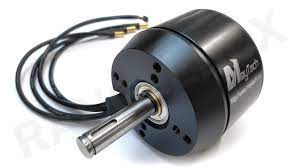Motors
Electric motors impart a continuous spinning motion and are used in nearly every combat robot. They work by creating a rotating magnetic field, which is used to spin a shaft or a shell at high speed. Many motors will be attached to a gearbox, generally used to decrease the shaft speed and increase torque.
Brushed (DC) Motors
DC Brushed motors have historically dominated the sport due to their availability and simplicity. These motors have an electrical connection to the spinning part of the motor using contacts called brushes.
DC motors have two wires or connections. Apply a suitable DC voltage to these and the motor will spin; reverse the connections, and the motor will spin in the opposite direction.
While these motors can be operated at full speed by switching power on and off as described, an electronic speed controller (ESC) will allow you to control speed by turning the power on and off in very fast pulses. Most ESCs can also reverse the motor direction while in use, so that weapons, tires, etc. can move both ways. Only ESCs made for brushed motors can be used.
Common brushed DC motors
There are literally hundreds of motors to choose from but certain choices have become favorites over the years due to their availability and suitability for robot combat. (N20, etc.; form a table if needed)
Brushless Motors
In recent years DC Brushless motors have become more popular. Brushless motors are often both faster and lighter than an equivalent brushed motor, while experiencing less friction, remaining more efficient and less susceptible to heat related failures.
Brushless motors have 3 or even 4 wires, and they will not operate at all without a brushless electronic speed controller (ESC). This specialized circuit synthesizes the rotating magnetic field by sending waves of power into pairs of wires in sequence. By altering which wires are used, the ESC can also reverse the motor; by adjusting the shape of the waves, it can change the speed and torque of the motor. This gives a builder many options, but can make setup of brushless motors very complicated.
Common brushless DC motors
(TBD)
Picking the right motor
There are tradeoffs between the two motor types so do a little research to determine which is most suitable for you.
Choosing a motor - Brushed or Brushless
